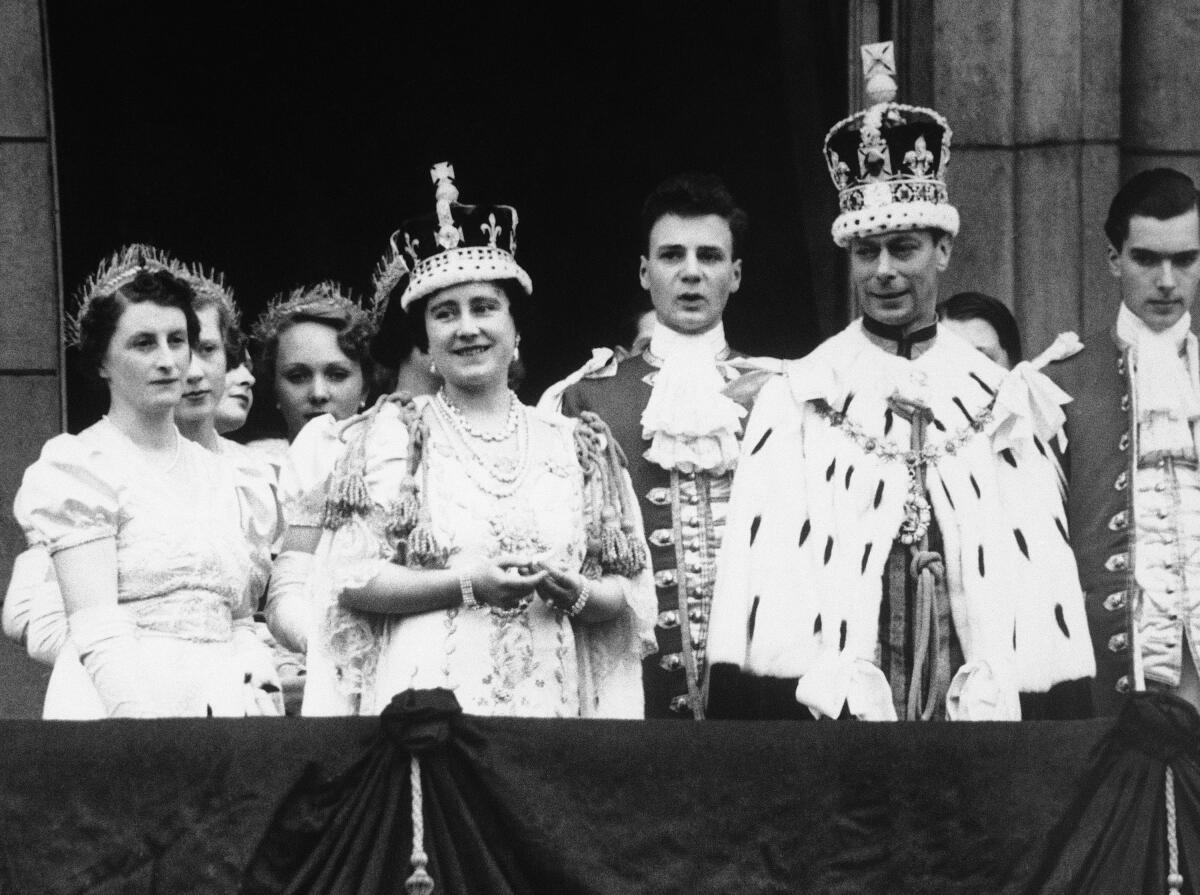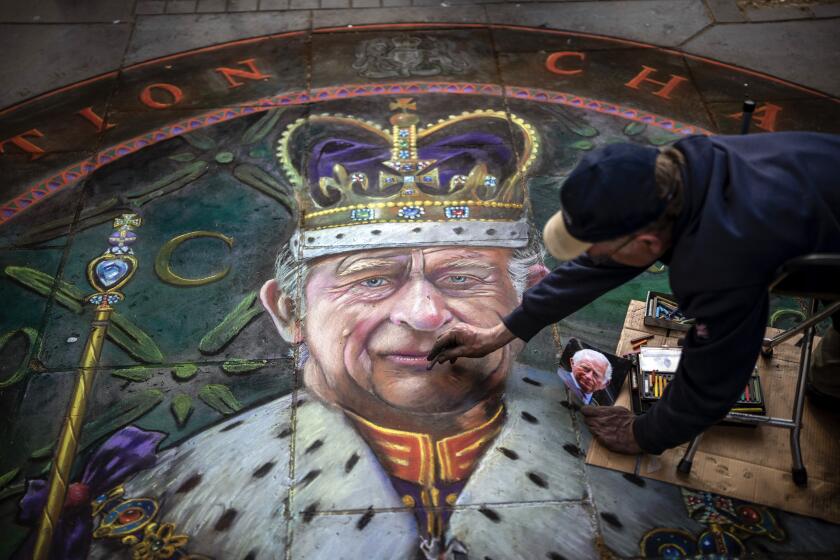Which king hired bouncers to block the queen from his coronation? Astonishing crowning moments

- Share via
LONDON — The British — as even they, maybe especially they, will tell you — do ceremonials better than anyone else in the world. They rehearse important funerals. And this week, on London streets, they staged midnight, moment-by-moment run-throughs for Saturday’s coronation of King Charles III.
But even coronations have had moments of mayhem and mishap, and over the centuries, those moments have given character and humanity to the most august events — incidents like these:
Wardrobe malfunctions
This one shook the new reign of Queen Elizabeth II down to its Wellington boots. Right there in Westminster Abbey, on coronation day in 1953, the new queen’s younger sister, Margaret, was photographed brushing a bit of fluff from the coat of the man she loved, a royal aide, a war hero, but a divorced one — Peter Townsend. The sister of the head of the Church of England marrying a divorced man? The matter divided the country, wounded the royal family, and scarred Margaret. She eventually gave him up.
Margaret and Elizabeth’s father faced his own clothing commotion at his coronation in 1937. King George VI arose from the throne — and found that he couldn’t move because a bishop was standing on his cloak. The king gave him a piece of his mind — “pretty sharply as I nearly fell down.”

Maybe the nuttiest coronation wardrobe maneuvering: The dress of Queen Caroline, wife of King George II, was so weighted down with jewels that courtiers had to rig up a pulley system to hoist her gown when she got up from the kneeling parts of the 1727 ceremony.
The crowning of King Charles III: Britain’s grand coronation spectacle evokes mirth or ire for some, but prompts reverence from others.
A favorite: As Ian Lloyd describes in “The Throne: 1,000 Years of British Coronations,” King Charles II gave the red silk coronation ensemble he wore to his 1661 coronation to a theater company. The king loved the theater — and actresses — and in 1664, he might have seen an actor named, of all things, Owen Tudor play King Henry V — in Charles II’s own clothes.
In 1377, 10-year-old King Richard II got mobbed by well-wishers after the coronation and lost one of his shoes. In the fashion of the time, people saw that as a bad omen. About two decades later, he lost his crown too, to his cousin.
Princess Diana’s ghost and another aggrieved royal wife
King Charles III’s wife has been officially identified as ‘Queen Camilla’ for the first time, with the title on the invitation for the coronation.
Some fans of the late Princess of Wales — dead more than a quarter-century now — will be crushed to see Camilla, the woman Diana called “the Rottweiler,” crowned as queen. Diana’s spirit, if it is in the vicinity, might make common cause with Caroline of Brunswick, the German wife of King George IV — the Real Hausfrau of Brunswick.
Caroline and her husband, who would become King George IV, immediately despised each other, reportedly for good reason — he drank, she stank. She went off to the Continent, but when George’s coronation neared in 1821 she came back, expecting to be crowned too. She was, technically, queen. George had anticipated this and given orders to keep her out of Westminster Abbey, even hiring prizefighters as queen-bouncers. She tried three different entrances and finally gave up. She died within a month.
Not just an English affair: King Charles III’s formal accession to the throne points up restiveness in Scotland, Wales and Northern Ireland.
So done with that
You might not think so, with the pomp and hype of the moment, but some coronation traditions have been abandoned. Chief among them, the coronation banquet, at which English kings feasted on eagle, boar’s head and peacock. The last was in 1821, for the rotund, spendthrift George IV. One of the reasons it was the last? The candles in the chandeliers overflowed and spattered wax on the clothes of the fancy people below.
Also abandoned after 1821, the centuries-old tradition of a “king’s champion” — wearing plumes and armor — riding into the banqueting hall and challenging to a duel anyone who disputed the king’s right to be king.
And alas for the public, another centuries-old tradition died out well before then: the fountains of central London running with red and white wine on coronation day.
One that the flora-loving Charles III might have revived is the old practice of the King’s Herb Woman walking before the royal procession, scattering fragrant herbs in its path.
Watching the coronation of King Charles III? Here’s what you should know about the crowns, scepters, orbs and more.
I told you to go before you left the palace
Henry VIII’s divorce from his first wife, Katherine of Aragon, was barely wrapped up when the multiple-marrier wed his next wife, Anne Boleyn. She was five months pregnant with the future Elizabeth I, whom Henry was sure would be a boy. He was always sure the next one would be a boy.

(Henry married six times, but none of his heirs had children. So, contrary to popular belief, King Charles III is not descended from Henry VIII, but from Henry’s elder sister, Margaret, queen of Scotland and grandmother of Mary, Queen of Scots.)
Anyway, Henry threw Anne a big coronation in 1533 to try to persuade his subjects to accept the marriage and their new queen. The crown placed upon her head was the one reserved for the actual monarch. At the coronation banquet, two women were deputized to sit under the table to help Anne to pee in situ when she had to go, which, given her pregnancy, must have been often.
Monty Python’s Flying Coronation
At Queen Victoria’s crowning in 1838, an elderly peer named Lord Rolle, going up the steps to pledge his loyalty to his new sovereign, took a tumble and … rolled, to the great amusement of those assembled in Abbey and beyond.
The poet Richard Harris Barham soon immortalized the moment in “Mr. Barney Maguire’s Account of the Coronation”:
Then the trumpets braying, and the organ playing,
And the sweet trombones, with their silver tones;
But Lord Rolle was rolling; —’t was mighty consoling
To think his Lordship did not break his bones!
The crowning of King Charles III — code-named Operation Golden Orb — was a display of heritage, tradition and spectacle unmatched around the world.
Royally duking it out
In 1911, Ian Lloyd writes, after the coronation of King George V and Queen Mary — it’s Mary’s crown that Camilla will wear at this coronation — the monarchs’ children were riding in a carriage behind their parents when two of their princely sons, Henry, 11, and George, 8, started fighting in a royal “punchup.”
When their sister, Mary, tried to break it up, she “nearly had her coronet knocked flying by the fractious pair.”
The plague and other problems
Two 17th century coronations were scaled back because of the plague.
In 1902, the coronation of Queen Victoria’s heir, King Edward VII, was postponed for several weeks. Just a couple of days before the original date, he became ill with an abscess on his appendix. He told doctors he wanted to go ahead with the ceremony, that he would “rather die in the Abbey.” He meant it dramatically, but they told him, yes, actually, he would.
So the coronation was postponed and the abscess was removed — by Frederick Treves, a surgeon who also worked with Joseph Merrick, dubbed the “Elephant Man.” Edward VII, whose nickname was “Tum Tum,” was reportedly pretty tickled that the surgery made him lose weight — about 8 inches off his 4-foot waist. After the coronation, the king made Treves a baronet.
Getting your priorities right
After the hours-long ordeal of her 1838 coronation, the newly crowned, 19-year-old Queen Victoria came home, took off her lavish duds ... and washed her dog.
More to Read
Sign up for Essential California
The most important California stories and recommendations in your inbox every morning.
You may occasionally receive promotional content from the Los Angeles Times.
















